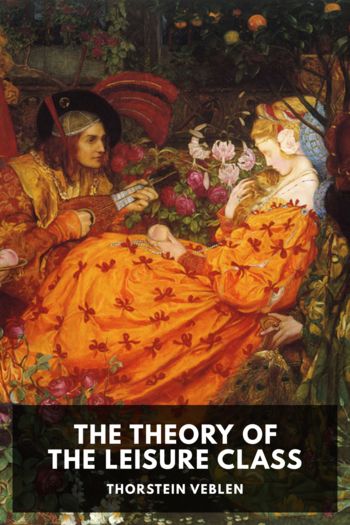The Theory of the Leisure Class by Thorstein Veblen (phonics readers TXT) 📕

- Author: Thorstein Veblen
Book online «The Theory of the Leisure Class by Thorstein Veblen (phonics readers TXT) 📕». Author Thorstein Veblen
On this ground, among objects of use the simple and unadorned article is aesthetically the best. But since the pecuniary canon of reputability rejects the inexpensive in articles appropriated to individual consumption, the satisfaction of our craving for beautiful things must be sought by way of compromise. The canons of beauty must be circumvented by some contrivance which will give evidence of a reputably wasteful expenditure, at the same time that it meets the demands of our critical sense of the useful and the beautiful, or at least meets the demand of some habit which has come to do duty in place of that sense. Such an auxiliary sense of taste is the sense of novelty; and this latter is helped out in its surrogateship by the curiosity with which men view ingenious and puzzling contrivances. Hence it comes that most objects alleged to be beautiful, and doing duty as such, show considerable ingenuity of design and are calculated to puzzle the beholder—to bewilder him with irrelevant suggestions and hints of the improbable—at the same time that they give evidence of an expenditure of labor in excess of what would give them their fullest efficency for their ostensible economic end.
This may be shown by an illustration taken from outside the range of our everyday habits and everyday contact, and so outside the range of our bias. Such are the remarkable feather mantles of Hawaii, or the well-known cawed handles of the ceremonial adzes of several Polynesian islands. These are undeniably beautiful, both in the sense that they offer a pleasing composition of form, lines, and color, and in the sense that they evince great skill and ingenuity in design and construction. At the same time the articles are manifestly ill fitted to serve any other economic purpose. But it is not always that the evolution of ingenious and puzzling contrivances under the guidance of the canon of wasted effort works out so happy a result. The result is quite as often a virtually complete suppression of all elements that would bear scrutiny as expressions of beauty, or of serviceability, and the substitution of evidences of misspent ingenuity and labor, backed by a conspicuous ineptitude; until many of the objects with which we surround ourselves in everyday life, and even many articles of everyday dress and ornament, are such as would not be tolerated except under the stress of prescriptive tradition. Illustrations of this substitution of ingenuity and expense in place of beauty and serviceability are to be seen, for instance, in domestic architecture, in domestic art or fancy work, in various articles of apparel, especially of feminine and priestly apparel.
The canon of beauty requires expression of the generic. The “novelty” due to the demands of conspicuous waste traverses this canon of beauty, in that it results in making the physiognomy of our objects of taste a congeries of idiosyncrasies; and the idiosyncrasies are, moreover, under the selective surveillance of the canon of expensiveness.
This process of selective adaptation of designs to the end of conspicuous waste, and the substitution of pecuniary beauty for aesthetic beauty, has been especially effective in the development of architecture. It would be extremely difficult to find a modern civilized residence or public building which can claim anything better than relative inoffensiveness in the eyes of anyone who will dissociate the elements of beauty from those of honorific waste. The endless variety of fronts presented by the better class of tenements and apartment houses in our cities is an endless variety of architectural distress and of suggestions of expensive discomfort. Considered as objects of beauty, the dead walls of the sides and back of these structures, left untouched by the hands of the artist, are commonly the best feature of the building.
What has been said of the influence of the law of conspicuous waste upon the canons of taste will hold true, with but a slight change of terms, of its influence upon our notions of the serviceability of goods for other ends than the aesthetic one. Goods are produced and consumed as a means to the fuller unfolding of human life; and their utility consists, in the first instance, in their efficiency as means to this end. The end is, in the first instance, the fullness of life of the individual, taken in absolute terms. But the human proclivity to emulation has seized upon the consumption of goods as a means to an invidious comparison, and has thereby invested consumable goods with a secondary utility as evidence of relative ability to pay. This indirect or secondary use of consumable goods lends an honorific character to consumption and presently also to the goods which best serve the emulative end of consumption. The consumption of expensive goods is meritorious, and the goods which contain an appreciable element of cost in excess of what goes to give them serviceability for





Comments (0)